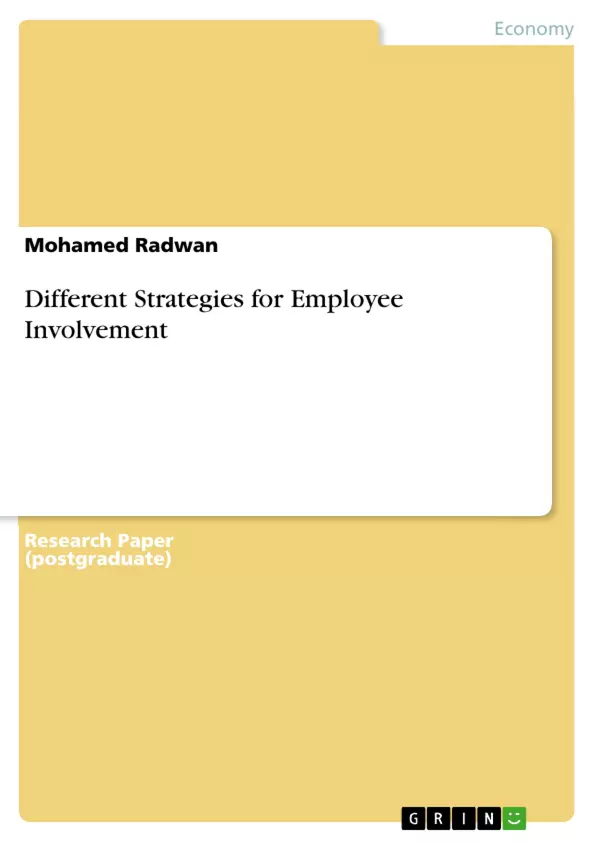Employee involvement is one of the most important aspects which affect the work performance and prove worker effectiveness. The main idea behind employees’ involvement is to transfer the knowledge from the top management level down to the employees who deal with the customers and daily operation because they are the best people who can give accurate feedback about the decision taken and its reflection to the organization and customers.
Human resource practices play a vital role in the employee involvement process as because of their strategic view they can align the employee interest with the firm interest to produce an employee who has the capability and the willingness of improving the organization.
The firm can get great benefit from involving and empowering employees by allowing them to discover and utilize their knowledge in the organization. It is not only about sharing information and about thinking how to improve work processes and performance, but the successful Implementation of the employees’ involvement may include the decision-making involvement and took some responsibilities with some freedom of innovation.
This paper will discuss the employees’ involvement strategies like motivation, teamwork, involvement and work performance and will discuss its opportunities and challenges while implementing it with different cultures.
Inhaltsverzeichnis (Table of Contents)
- INTRODUCTION
- MOTIVATION
- EMPLOYEE INVOLVEMENT
- TEAMWORK
- WORK PERFORMANCE
- KPI METHOD FOR MEASURING WORK PERFORMANCE
- COMPANY OVERVIEW
- IMPLEMENTING MOTIVATION ON TARGET COUNTRIES OPPORTUNITIES AND CHALLENGES
- OPPORTUNITIES, CHALLENGES AND COMMUNICATION PROBLEMS
- IMPLEMENTING TEAMWORK ON TARGET COUNTRIES OPPORTUNITIES AND CHALLENGES
- OPPORTUNITIES, CHALLENGES AND COMMUNICATION PROBLEMS
- IMPLEMENTING EMPLOYEE INVOLVEMENT ON TARGET COUNTRIES OPPORTUNITIES AND CHALLENGES
- IMPLEMENTING WORK PERFORMANCE ON TARGET COUNTRIES OPPORTUNITIES AND CHALLENGES
- RECOMMENDATION FOR THE OVERALL EMPLOYEE INVOLVEMENT STRATEGY
- ROLE OF VIRTUAL COMMUNICATION
- CONCLUSION
- REFERENCES
Zielsetzung und Themenschwerpunkte (Objectives and Key Themes)
This paper aims to explore the significance of employee involvement in enhancing work performance and organizational effectiveness. It delves into various strategies for fostering employee involvement, including motivation, teamwork, and work performance, within the context of different cultural contexts.
- Employee Involvement and its impact on work performance and organizational effectiveness
- Motivation theories and their application in improving employee engagement
- Teamwork dynamics and their role in maximizing productivity
- Key considerations for implementing employee involvement strategies across diverse cultures
- Opportunities and challenges associated with promoting employee involvement in a globalized business environment
Zusammenfassung der Kapitel (Chapter Summaries)
The paper begins by introducing the concept of employee involvement and its importance in driving organizational success. It highlights the significance of knowledge transfer from management to employees, emphasizing the value of employee feedback in decision-making processes.
The chapter on motivation delves into the core theories of employee motivation, exploring the work of Maslow and Herzberg. It examines the different levels of needs outlined by Maslow's Hierarchy of Needs, including physiological, safety, social, esteem, and self-actualization needs, and how these can be addressed through motivational strategies. It also discusses the two-factor theory proposed by Herzberg, which emphasizes the importance of both hygiene factors (e.g., salary, benefits) and motivator factors (e.g., promotions, achievement) in influencing employee motivation.
The chapter on employee involvement explores the positive impact of employee participation on organizational performance, covering topics like shared decision-making, policy setting, and productivity enhancement. The JD-R model is introduced, focusing on job demands and resources, and their influence on work engagement.
The chapter on teamwork explores the benefits of teamwork, focusing on the diversity of knowledge and skills that teams bring together to achieve common goals. It provides an overview of Tuckman's five stages of team development: forming, storming, norming, performing, and adjourning, offering guidance on the role of team leaders in facilitating each stage.
Schlüsselwörter (Keywords)
The paper focuses on key concepts including employee involvement, motivation, teamwork, work performance, cultural diversity, and organizational effectiveness. It examines different theories and models such as Maslow's Hierarchy of Needs, Herzberg's Two-Factor Theory, the JD-R model, and Tuckman's stages of team development.
- Citation du texte
- Mr Mohamed Radwan (Auteur), 2017, Different Strategies for Employee Involvement, Munich, GRIN Verlag, https://www.grin.com/document/424827



